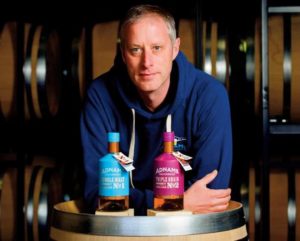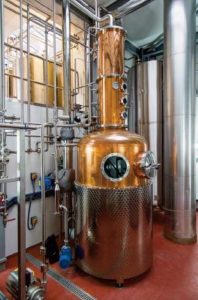Another Suffolk Success Story – Time for a G & T?
This is the fourth Suffolk Success Story and time to raise your glass to Adnams. Previous stories have covered Jim Lawrence, Churchill Kitchens and, last year, Sarah Cook and her Benton Irises.
Before reading about the success of Adnams in their distillery, it is worth looking at the history of gin and the later arrival of vodka.
It is thought that gin was first produced in Holland in the early 17th Century, although Italy claims it was produced there even earlier. In Holland it was a medicine used to cure stomach problems, and to make it more palatable, the Dutch flavoured it with juniper, which has its own medicinal properties. Juniper
comes from high altitudes, mainly in Italy and Germany.
During the 30 Years War, which started in 1618, British troops were given “Dutch Courage” to help ward off the cold in the Low Countries, and when they returned home they brought gin back with them. Gin was very hard to find and then mostly in chemists shops, where it was sold as a medicine.
The Worshipful Company of Distillers was formed by Charles I in 1638, and this gave sole rights to distill spirits in London and Westminster and within 21 miles. This improved the quality of gin and also helped farmers sell surplus corn and barley.
In 1689 William III (William of Orange) issued various statutes encouraging the distillation of English spirits and by 1730 there were over 7,000 premises selling only spirits, which led to serious alcohol problems. This problem was tackled by the passing of The Gin Act in 1736, making it prohibitively expensive. However this, like the more recent Poll Tax, was detested by the populace who rioted and the law became unenforceable.
It is estimated that at this time (1736) 11 million gallons of gin were distilled in London, equivalent to 14 gallons per person, and this was an increase of 20 times the figure of 1690.
The Gin Act was repealed in 1742 and a system, not unlike today, was introduced, supervised by magistrates. By the early 1800s, competition between beer shops and gin shops became fierce, leading to the Beerhouse Act of 1820 which freed beer from licensing. In order to compete, the spirit trade devised “gin palaces”, which numbered about 5,000 in London alone. By 1869 drunkenness led to an Act requiring beer and wine sales to be through licensed premises and this was followed, in 1871, by a proposed Act which would have halved the number of licensed premises. Once again, public outrage won the day, and, as one Bishop in the House of Lords put it, “I would prefer to see all England free, better than England sober”.
In the 1920s gin triumphed as the Cocktail drink and the USA exported to the UK the cocktail hour – the time between tea time and dinner. London dry gin became the staple ingredient in many fashionable drinks such as the Dry Martini. By 1951 the Bartenders Guild had over 7,000 registered cocktails.

John McCarthy
Fast forward to 2009 when Jonathan Adnams wanted to find ways to broaden the Adnams product base, and he came up with the idea of a distillery in Southwold. In 2010 Jonathan took John McCarthy, one of the Engineering Team mainly involved with control systems, on a course in Michigan and on the plane back John asked Jonathan who he was going to get to be the “Distiller” and Jonathan suggested that John give it a try. John has subsequently taken the diploma in distilling to learn the art of distillation. Meanwhile, work had been in hand to install a distillery within the brewery buildings in Southwold, something overseen by John. By October 2010 everything was ready and the first alcohol was distilled, leading to the first Adnams Gin and Vodka. Initially bottling was in a tiny room at the top of the brewery, not ideal as all bottles had to be brought up three floors, filled and then taken back down. This was the situation when I last visited the brewery in 2011, when I was writing an article for the 2012 Magazine on “The Art of Brewing”. Initially, only about 1,000 bottles of Gin and Vodka were produced.
In 2017 over 150,000 bottles of spirits were produced between January and August. The business has increased exponentially at around 60/70% per annum and this year looks like being 70/80% higher than last year. Bottling has been outsourced to Burlingtons in Witham, a business run by Christopher Hayman. Bottles are filled at the rate of 50 bottles a minute, whereas in Southwold they were filling only 50 bottles per hour. All spirits start as a wash, which is basically beer without hops. Vodka is used as the base spirit for Gin and it has to be distilled to above 96% ABV. The alcohol comes from the fermenting of barley, wheat, oats and rye. The best neutral alcohol is completely flavourless. Gin is created by the addition of “botanicals” of which, juniper berries are the leading ingredient. The Adnams Copper House Gin is their premiere brand and other ingredients are Orris Root, Coriander Seed, Cardamom Pod, Hibiscus Flower, and Sweet Orange Peel. Their other Gin, Finest Cut Gin, has no Hibiscus Flowers, but has the addition of Lemon Peel, Cassia Bark, Vanilla Pod, Angelica Root, Caraway Seed, Fennel Seed, Thyme and Liquorice Root. These two recipes were the winners out of some 30 different mixes of botanicals tried out by John.

Adnams Gin still
The Copper House Distillery is within the main brewery which is reckoned to be the most energy efficient in the UK; the distillery also generating hot water for use in the brewery. The equipment is German, made by Carl of Eisingen. To make spirits, something called a “Wash” is produced which is basically beer without hops. This is then fermented using a very old strain of yeast. This is then pumped into the distillery, using a strangely named bit of equipment called a Beer Stripping Column, and is converted into what is called Low Wines. This has an ABV of about 80% but contains higher alcohols and fusel oils which need to be removed, which is done by using the pot still in conjunction with rectifying columns, and a polishing column. Forty plates are used in the rectifying columns to ensure the spirit is above 96% ABV and it is separated into Heads, Hearts and Tails. The Polishing Column removes any Methanol in the spirit, and it is now ready to be infused with the botanicals overnight, before being distilled the next day. (If you have understood all this, you have done well, but for a more detailed explanation go to the Adnams website!)
The Copper House Gin has won several awards including being voted the World’s Best Gin in 2013 as well as being the overall winner of the International Wine & Spirit Competition in 2013, as well as the Gold winner. The Vodka won the IWSC Gold in 2014.The Longshore Vodka won a trophy in 2017 as did Gin, with a Silver Outstanding and Gold for a Gin & Tonic.. There are plans for an Adnams Tonic which should be on the shelves by the time this article is published.
The first major breakthrough, in marketing the Adnams spirits, came when Waitrose decided that it was something they wanted to sell. This was in 2112. Since then all spirit sales have taken off and canned G & T has become very popular. At the start of 2017, 100,000 cans were produced and meant to last a year. However, a further 100,000 cans have had to be produced! With these pressures, the distillery is kept working 24 hours a day from 22.00 on a Sunday evening to 22.00 on a Friday evening.
Adnams also produce a Whisky, but because it takes a minimum of three to five years to mature in cask, it lags behind the gin and vodka. The long term storage of casks is, of course, another factor. 500 casks are stored in Southwold and a further 500 in London. Each cask contains 225 litres. Casks are made from French oak which infuses a vanilla and spice flavour; and American oak, which infuses a vanilla and coconut flavour. The French casks cost 660 Euros, whereas the American casks cost 400 Euros.
John has introduced a further spirit in the form of a liqueur, “Sloe Gin”. Copper House gin is used with sugar added, a legal requirement; 100 grams per litre minimum. Current production is about 2,000 bottles every three months. The sloes currently come from Poland. The ABV is 26%. It is a much lighter colour than most other Sloe Gins.
Having got this far, now comes the moment when you can take part and produce your own flavoured gin. In Southwold and also in the shop in Bury St Edmunds there are mini stills to produce a single bottle of gin. You choose your botanicals and watch them distill! There are five sessions a week but you will need to book. Go to Adnams Website. This sounds like an excellent idea for a Birthday or Christmas present when you have run out of ideas! As a final point, I remember going to an Adnams AGM in, I think, 2010 or 2011 and the Chairman, Jonathan Adnams, and the Company were, in my view, very unfairly criticised for departing from solely beer production into Cellars and Kitchens and other areas, such as spirit production; something the shareholders considered were side-lines. How wrong they were!
I am grateful to John McCarthy for educating me about the World of Spirits.
Mark Dawson
